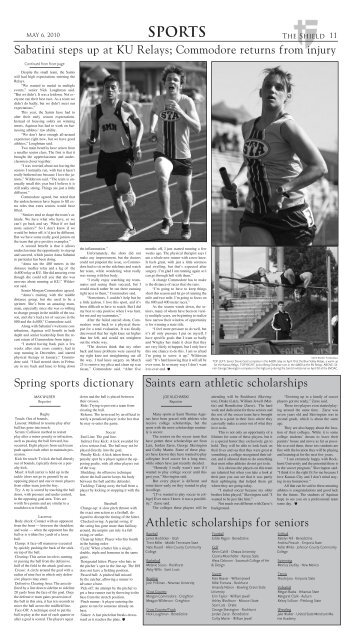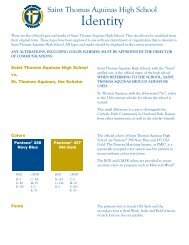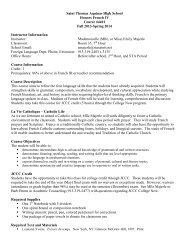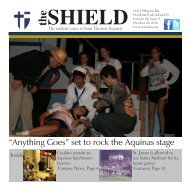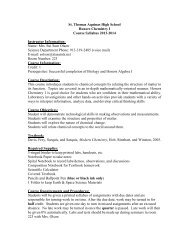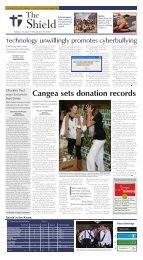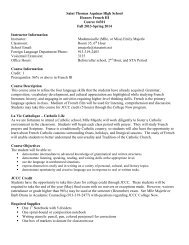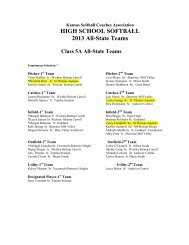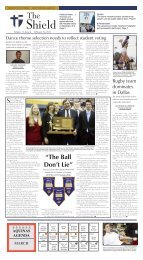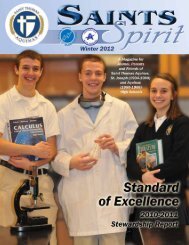2010 05 06 - Saint Thomas Aquinas High School
2010 05 06 - Saint Thomas Aquinas High School
2010 05 06 - Saint Thomas Aquinas High School
- No tags were found...
Create successful ePaper yourself
Turn your PDF publications into a flip-book with our unique Google optimized e-Paper software.
MAY 6, <strong>2010</strong>SPORTS The Shield 11Sabatini steps up at KU Relays; Commodore returns from injuryContinued from front pageDespite the small team, the <strong>Saint</strong>sstill had high expectations entering theRelays.“We wanted to medal in multipleevents,” senior Nick Loughman said.“But we didn’t. It was a letdown. Not everyoneran their best race. As a team wedidn’t do badly, but we didn’t meet ourexpectations.”This year, the <strong>Saint</strong>s have had toalter their early season expectations.Instead of focusing solely on winningmeets, <strong>Aquinas</strong> has had to work on harnessingathletes’ raw ability.“We don’t have enough all-aroundexperience right now, but we have goodathletes,” Loughman said.Two main benefits have arisen froma smaller senior class. The first is that itbrought the upperclassmen and underclassmencloser together.“I was worried about not having theseniors I normally run, with but it hasn’treally bothered me because I love the juniors,”Wilderson said. “The team is unusuallysmall this year but I believe it isstill really strong. Things are just a littledifferent.”Commodore agreed, but noted thatthe underclassmen have begun to fill extraroles that extra seniors would havefilled.“Seniors tend to shape the team’s attitude.We have what whe have, so wecan’t go back and say ‘What if we hadmore seniors?’ So I don’t know if wewould be better off; it’d just be different.But we have some really good juniors onthe team that give positive examples.”A second benefit is that it allowsunderclassmen the opportunity to step upand succeed, which junior Anna Sabatiniin particular has been doing.“Anna ran the 400 meters in thedistance medley relay and a leg of the4x800 relay at KU. She did amazing eventhough she could tell you that she wasnervous about running at KU,” Wildersonsaid.Senior Morgan Commodore agreed.“Anna’s training with the middledistance group, but she used to be asprinter. She’s been an amazing teammate,especially since she was so willingto change groups in the middle of the season,and she’s had a lot of success in the800 and the 4x800,” Commodore said.Along with Sabatini’s welcome contributions,<strong>Aquinas</strong> will benefit in bothdepth and senior leadership from the recentreturn of Commodore from injury.“I started having back pain a fewweeks after state cross country, had tostop running in December, and startedphysical therapy in January,” Commodoresaid. “I had steroid shots in Februaryin my back and knee to bring downthe inflammation.”Unfortunately, the shots did notmake any improvement, but the doctorscould not pinpoint the issue, so Commodorehad to sit on the sidelines and watchher team, while wondering what reallywas wrong with her body.“I really enjoy watching my teammatesand seeing them succeed, but Iwould much rather be out there runningright next to them,” Commodore said.“Sometimes, I couldn’t help but bea little jealous. I love this sport, and it’sbeen difficult to have to watch. But I didmy best to stay positive when I was hurt,for me and my teammates.”After the failed steroid shots, Commodorewent back to a physical therapistfor a total evaluation. It was finallydiscovered that her right knee sat higherthan her left, and would not straightenout the whole way.“The doctors think that my otherback and knee problems were caused bymy right knee not straightening out allthe way. I had knee surgery on March25 to remove my plica and clean up scartissue,” Commodore said. “After fivemonths off, I just started running a fewweeks ago. The physical therapist says Iam a whole new runner with a new knee.It feels great, with just a little sorenessand swelling, but that’s expected aftersurgery. I’m glad I am running again so Ican go through hell with them.”A change Commodore has to makeis the distance of races that she runs.“I’m going to have to keep thingsshort this season and let go of running themile and two mile. I’m going to focus onthe 800 and 400 meter races.”As the season winds down, the seniors,many of whom have been on varsitymultiple years, are beginning to realizehow narrow their window of opportunityis for winning a state title.“I feel more pressure to do well, butit’s all only pressure I put on myself. Ihave specific goals that I want so badlyand Wrigley has made it clear that theyare very likely to happen, but I only havethis one chance to do this. I am so afraidI’m going to screw it up,” Wildersonsaid. “It’s hard knowing that it will all beover soon. In so many ways I don’t wantit to ever end. dKATIE BOLIN/ The MedallionTOP LEFT: Senior Stevie Geist competes in the 4x800 relay on April 10 at the Blue Valley Relays, a warm-upfor the Kansas Relays. TOP RIGHT: Junior Betsy Donahue runs in the 4x800 at the BV Relays. ABOVE: SeniorGeorge Skevington competes in the high jump during the <strong>Saint</strong>s Invitational on April 30 at the BVDAC.Spring sports dictionary<strong>Saint</strong>s earn athletic scholarshipsMAX WILBERReporterRugbyTouch: Out of bounds.Lineout: Method to resume play afterball has gone into touch.Scrum: Collision method to restartplay after a minor penalty or infraction,such as passing the ball forward, hasoccurred. Eight players from each teampush against each other to maintain possession.Kick for touch: To kick the ball directlyout of bounds, typically done on a penaltykick.Maul: A ball carrier is held up in thetackle (does not go to ground) by anopposing player and one or more playersfrom either team join the fray.Try: A try is scored by touching the balldown, with pressure and under control,in the opposing goal area. Tries areworth five points and are similar to atouchdown in football.LacrosseBody check: Contact with an opponentfrom the front — between the shouldersand waist — when the opponent has theball or is within five yards of a looseball.Clamp: A face-off maneuver executedby quickly pushing the back of the stickon top of the ball.Clearing: This action involves runningor passing the ball from the defensivehalf of the field to the attack goal area.Crease: A circle around the goal with aradius of nine feet in which only defensiveplayers may enter.Defensive Clearing Area: The area definedby a line drawn sideline to sideline20 yards from the face of the goal. Oncethe defensive team gains possession ofthe ball in this area, it has ten seconds tomove the ball across the midfield line.Face-Off: A technique used to put theball in play at the start of each quarter orafter a goal is scored. The players squatdown and the ball is placed betweentheir crosses.Ride: Trying to prevent a team fromclearing the ball.Release: The term used by an official tonotify a penalized player in the box thathe may re-enter the game.SoccerEnd Line: The goal line.Indirect Free Kick: A kick awarded fora less serious foul. The ball may not beplayed directly into the goal.Penalty Kick: A kick taken from apenalty spot by a player against the opposinggoalie, with all other players outof the way.Shielding: An offensive techniquewhere the ball carrier keeps his bodybetween the ball and the defender.Tackling: Taking away the ball from aplayer by kicking or stopping it with thefeet.BaseballChange-up: A slow pitch thrown withthe exact arm action as a fastball, designedto disrupt the timing of the hitter.Checked swing: A partial swing; ifthe swing has gone more than halfwayaround, the umpire can rule it a fullswing, or strike.Clean-up hitter: Player who hits fourthin the batting orderCycle: When a batter hits a single,double, triple and homerun in the samegame.Designated hitter: Player who bats inthe pitcher’s spot in the line-up. The DHdoes not have a fielding position.Passed ball: A pitched ball missedby the catcher, allowing a runner toadvance a base.Pick-off: An attempt by the pitcher toget a base runner out by throwing to thebase from the stretch position.Pinch runner: A player entering thegame to run for someone already onbase.Sinker: A fast pitch that breaks downwardas it reaches the plate. dJOE KUCHARSKIReporterMany sports at <strong>Saint</strong> <strong>Thomas</strong> <strong>Aquinas</strong>have been graced with athletes whoreceive college scholarships, but thesport with the most scholarships routinelyis soccer.The seniors on the soccer team thathave gotten these scholarships are SeanLatz, Jordan Zarse, George Skevingtonand Colby Martin. Some of these playershave known they have wanted to playcollegiate level soccer for a long time,while others have just recently decided.“Honestly I really wasn’t sure if Iwanted to play college soccer until thispast year,” Skevington said.But every player is different andsome knew early on they wanted to playin college.“[I’ve wanted to play soccer in college]Ever since I knew it was a possibility,”Zarse said.The colleges these players will beBaseballJames Boddicker - UtahTrent Miller - Middle Tennessee StateNate Russell - Allen County CommunityCollegeBasketballMelanie Siscos - RockhurstAbby Willis - <strong>Saint</strong> LouisBowlingJosh Prilliman - Newman UniversityCross CountryMorgan Commodore - CreightonMeagan Wilderson - CreightonCross Country/TrackNick Loughman - Benedictineattending will be Rockhurst (Skevington),Drake (Latz), William Jewell (Martin)and Benedictine (Zarse). The hardwork and dedication for these seniors andthe rest of the soccer team have broughtthem to a point in their lives where theycan really make a career out of what theylove to do.This is not only an opportunity of alifetime for some of these players, but itis a special honor they exclusively get tohold. They will be able to look back ontheir lives and say that they were great atsomething, a college recognized their talent,and it allowed them to do somethingthat most other athletes do not get to do.It is obvious the players on this teamare talented but when you take a look attheir past you can see that it was partlytheir upbringing that helped them getwhere they are going today.“I started soccer because my olderbrother John played,” Skevington said. “Iwanted to be just like him.”Not much was different with Zarse’sbackground.FootballEddie Regan - BenedictineGolfKevin Cahill - Ottawa UniversityGianna Misenhelter - Kansas StateAlexa Osbourn - Savannah College of Art& DesignSoccerKate Beaver - William JewellNikki Fontana - RockhurstAmanda Nelson - Bowling Green StateUniversityErin Taylor - Willliam JewellAshley Washburn - Missouri StateSean Latz - DrakeGeorge Skevington - RockhurstJordan Zarse - BenedictineColby Martin - William Jewell“Growing up in a family of soccerplayers got me ready,” Zarse said.These two players even started playingaround the same time. Zarse wasseven years old and Skevington was insecond grade, which is about the sameage.They are also happy about the locationof their colleges. While it is somecollege students’ dream to leave theirparents’ house and move as far as possibleto avoid them, these two students arefine with the location they will be playingand learning at for the next few years.“ I am extremely happy with RockhurstUniversity and the potential there isin the soccer program,” Skevington said.“I think it is the right fit for me because Ilove Kansas City and I don’t mind stayingin my hometown.”All that can be said to these amazingathletes is congratulations and good luckfor the future. The students of <strong>Aquinas</strong>hope to see you on a professional teamsome day. dAthletic scholarships for seniorsSoftballKatelyn Nill - BenedictineAndrea Piezuch - Emporia StateKellie White - Johnson County CommunityCollegeSwimmingMonica Dudley - New MexicoTennisNicole Jara - Emporia StateVolleyballMegan Baska - Arkansas StateMargaret Clark - AuburnKelsey Sullivan - Pittsburg StateWrestlingJake Walker - United State Merchant MarineAcademy


